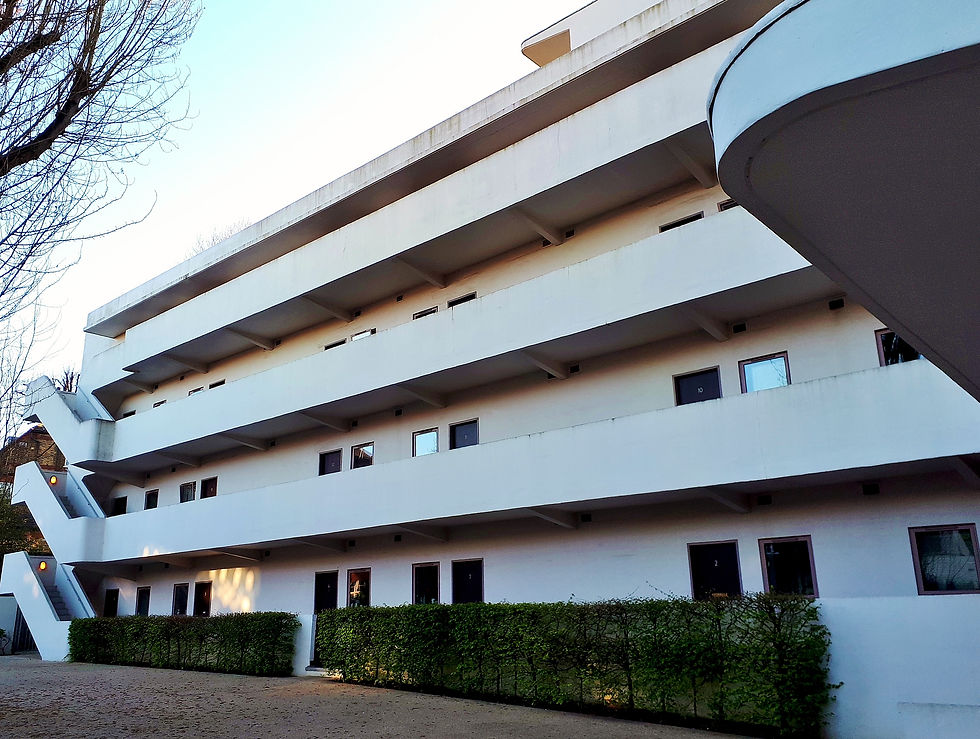A London modernist icon: Isokon Flats
- London On The Ground

- Mar 28, 2022
- 3 min read
Britain's first modernist block of flats was home to intellectuals, spies and Agatha Christie.

The strikingly sleek and simple 1930s building was originally called Lawn Road Flats because of its address in London's Belsize Park district.
The brainchild of furniture entrepreneur Jack Pritchard and his wife Molly, a psychiatrist, the Isokon building was designed by Canadian architect Wells Coates and opened on 9 July 1934. Germany's Bauhaus art and design school was a significant influence on the Pritchards and Coates.
All three were directors of the Isokon Furniture Company, founded by Jack Pritchard and Wells Coates in 1931 to design and make modernist furniture for modernist houses and flats. The name 'Isokon' was derived from the term 'Isometric Unit Construction'.
The company pioneered the use of bent plywood and employed Bauhaus designers to create 20th century classics such as the Long Chair and the Penguin Donkey (a book case specifically designed for Penguin paperbacks). The brand continues today as Isokon Plus.
The Isokon building, made with reinforced concrete, was designed to provide a new, minimalist, style of urban living for residents in the 32 flats. The flats had built-in plywood furniture, made by a company called Vanesta, for whom Jack Pritchard was also a senior executive. According to early advertising, all you had to bring with you was "a rug, an armchair and a picture”.
The 'minimum flats' for single people occupied only 24 square metres, with only a galley kitchen, but residents also benefited from a communal kitchen and a dumb waiter. There were also staff quarters, a large garage and services such as shoe cleaning, bed-making and laundry.

In 1937 a restaurant and bar, called the Isobar, was added, which became a social hub for residents and visitors from the intelligentsia of North London and beyond . The Isobar's regular clientele included the artists and sculptors Henry Moore, Barbara Hepworth, Naum Gabo, Ben Nicholson and the biologist Sir Julian Huxley.
The Pritchards occupied a one bedroom penthouse, while their two sons were next door in a studio flat. Among the other residents before World War II were leading European artists and intellectuals fleeing Europe, including three celebrated Bauhaus School figures now commemorated by an English Heritage blue plaque: the school's founder Walter Gropius, furniture designer Marcel Breuer and its head art teacher László Maholy-Nagy.

Other notable residents in the 1930s included Arnold Deutsch, who was a Soviet spy and recruited the so-called Cambridge Five (which included Kim Philby) to work for the KGB (then called NKVD). Another Soviet spy, German-born economist Juergen Kuczynski, also lived there.
From 1941 to 1947, author Agatha Christie lived in the building with her second husband, archaeologist Max Mallowan. Art historian Adrian Stokes, author Nicholas Monsarrat, architect Jacques Groag, his textile designer wife Jacqueline Groag and architect James Stirling (designer of Number 1 Poultry in the City of London, subject of a previous post on this blog) were among the many other people from the creative and artistic professions who were resident in the Isokon at some time.
In 1969, Pritchard sold the building to the New Statesman magazine and the Isobar restaurant was replaced by four more flats. Three years later, Camden Council acquired the building for twice the price paid by the New Statesman. However, in spite of a Grade II listing in 1974 (upgraded to Grade I in 1999), Camden did not look after the Isokon well. For a while it housed single men with addiction and mental health problems. Eventually derelict in the 1990s, the threat of demolition sparked a campaign to save it.
Notting Hill Housing Association bought the Isokon in 2003, when it was refurbished by Avanti Architects. The work included removing an outer layer of render and adding an exterior finish closer to the original. Today, the majority of the 36 flats are occupied under shared ownership by key workers such as nurses and teachers.
Since 2014 the former garage has been a museum and gallery space, with exhibits illustrating the history of the Isokon building, its residents and the Isokon company. The gallery, which is free to enter, is open at weekends from 11am to 4pm between March and October.










Comments